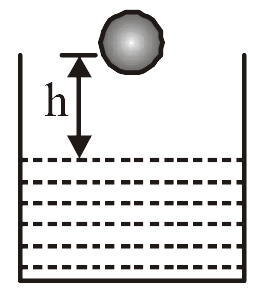A small ball of radius 'r' falls freely under gravity through a distance 'h' before entering a tank of water. If after entering the water, the velocity of ball does not change, the 'h' is proportional to
Step by step video & image solution for A small ball of radius 'r' falls freely under gravity through a distance 'h' before entering a tank of water. If after entering the water, the velocity of ball does not change, the 'h' is proportional to by Physics experts to help you in doubts & scoring excellent marks in Class 12 exams.
Similar Questions
A spherical ball of radius 3×10−4m and density 104kg/m3 falls freely under gravity through a distance h before entering a tank of water. If after entering the water the velocity of the ball does not change, find h the viscosity of water is 9.8×10−6N−s/m2
View SolutionA spherical ball of radius 3.0×10−4m and density 104kg/m3 falls freely under gravity through a distance h before entering a tank of water. If after entering the water the velocity of the ball does not change, find h. Viscosity of water is 9.8×106N−s/m2.
View Solution
Knowledge Check
- Question 1 - Select One
A metal ball ofradius 10−4 m and density 104kg/m3 falls freely under gravity through a distance 'h' and enters a tank of water. It is found that after entering the water, the velocity of ball does not change. What is the value of h?
[ηfor water 10−5 Pas ,g=10m/s2 and orhwater=103kg/m3]A10mB15mC18mD20m - Question 2 - Select One
A small steel ball of mass m and radius r is falling under gravity through a viscous liquid of coefficient of viscosity η. If g is the value of acceleration due to gravity. Then the terminal velocity of the ball is proportional to (ignore buoyancy)
Amg(η)rBmg(η)rCmgrηDmgrη - Question 3 - Select One
A small steel ball of radius r is allowed to fall under gravity through a column of a viscous liquid of coefficient of viscosity η. After some time the velocity of the ball attains a constant value known as terminal velocity υT. The terminal velocity depends on (i) the mass of the ball m (ii) η, (iii) r and (iv) acceleration due to gravity g . Which of the following relations is dimensionally correct?
AvT∝mgηrBvT∝ηrmgCvTηrmgDvT∝mgrη
A spherical ball of radius 3.0×10−4 m and density 104kgm3 falls freely under gravity through a distance H=n×500m before entering a tank of water. If after enerting the water the velocity of the ball does not change, then find n. viscosity of water is 10×10−6N−sm2,g=10ms
View SolutionIn an experiment to verify Stokes law , a small spherical ball of radius r and density ρ falls under gracvity throught a distance h in air before entering a tank of wate . If the terminal velocity of the ball inside water is same as its velocity just befor entering the water surface , then the value of h is proportional to : ( ignore viscosity of air ) .
View SolutionA ball of radius r and density r falls freely under gravity through a distance h before entering water. Velocity of ball does not change even on entering water. If viscosity of water is η the value of h is given by
 View Solution
View SolutionA solid ball of density half that of water falls freely under gravity from a height of 20m and then enters water. Up to what depth will the ball go ? How much time will it take to come again to the wate surface ? Neglect air resistance and viscosity effect in water.
View SolutionA soild ball of density half that of water falls freely under gravity from a height of 19.6 m and then enters water. Upto what depth will the ball go. How much time will it take to come again to the water surface? Neglect air resistandce and viscosity effects in water. (Take g=9.8m/S2).
View Solution
